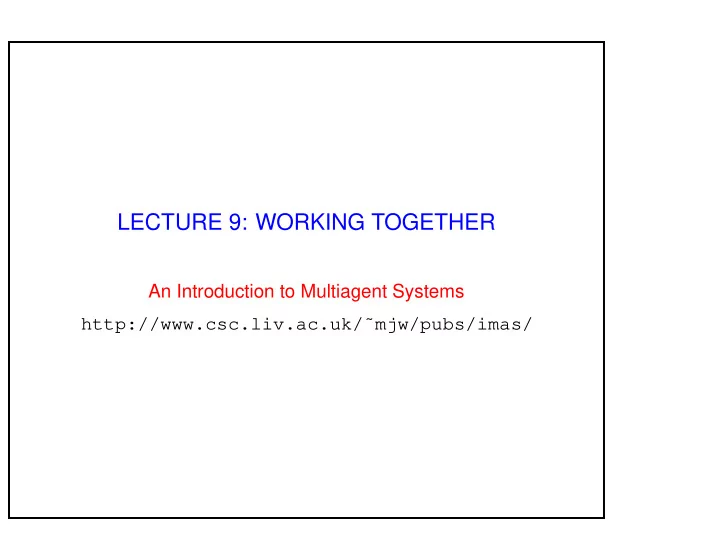

LECTURE 9: WORKING TOGETHER An Introduction to Multiagent Systems http://www.csc.liv.ac.uk/˜mjw/pubs/imas/
� � Lecture 9 An Introduction to Multiagent Systems 1 Working Together Why and how to agents work together? Important to make a distinction between: – benevolent agents and – self-interested agents . 1 http://www.csc.liv.ac.uk/˜mjw/pubs/imas/
� � � � Lecture 9 An Introduction to Multiagent Systems 1.1 Benevolent Agents If we “own” the whole system, we can design agents to help each other whenever asked. In this case, we can assume agents are benevolent : our best interest is their best interest. Problem-solving in benevolent systems is cooperative distributed problem solving (CDPS). Benevolence simplifies the system design task enormously! 2 http://www.csc.liv.ac.uk/˜mjw/pubs/imas/
� � � � Lecture 9 An Introduction to Multiagent Systems 1.2 Self-Interested Agents If agents represent individuals or organisations, (the more general case), then we cannot make the benevolence assumption: Agents will be assumed to act to further there own interests, possibly at expense of others. Potential for conflict . May complicate the design task enormously. 3 http://www.csc.liv.ac.uk/˜mjw/pubs/imas/
� Lecture 9 An Introduction to Multiagent Systems 2 Task Sharing and Result Sharing Two main modes of cooperative problem solving: – task sharing : components of a task are distributed to component agents; – result sharing : information (partial results etc) is distributed. 4 http://www.csc.liv.ac.uk/˜mjw/pubs/imas/
� Lecture 9 An Introduction to Multiagent Systems 3 The Contract Net Well known task-sharing protocol for task allocation is contract net : 1. Recognition; 2. Announcement; 3. Bidding; 4. Awarding; 5. Expediting. 5 http://www.csc.liv.ac.uk/˜mjw/pubs/imas/
Lecture 9 An Introduction to Multiagent Systems I have a problem... A1 A2 A3 (a) Recognising (b) Task announcement the problem A4 (c) Bidding (d) Awarding the contract 6 http://www.csc.liv.ac.uk/˜mjw/pubs/imas/
� Lecture 9 An Introduction to Multiagent Systems 3.1 Recognition In this stage, an agent recognises it has a problem it wants help with. Agent has a goal, and either. . . – realises it cannot achieve the goal in isolation — does not have capability; – realises it would prefer not to achieve the goal in isolation (typically because of solution quality, deadline, etc) 7 http://www.csc.liv.ac.uk/˜mjw/pubs/imas/
� � � Lecture 9 An Introduction to Multiagent Systems 3.2 Announcement In this stage, the agent with the task sends out an announcement of the task which includes a specification of the task to be achieved. Specification must encode: – description of task itself (maybe executable); – any constraints (e.g., deadlines, quality constraints). – meta-task information (e.g., “bids must be submitted by. . . ”) The announcement is then broadcast . 8 http://www.csc.liv.ac.uk/˜mjw/pubs/imas/
� � � Lecture 9 An Introduction to Multiagent Systems 3.3 Bidding Agents that receive the announcement decide for themselves whether they wish to bid for the task. Factors: – agent must decide whether it is capable of expediting task; – agent must determine quality constraints & price information (if relevant). If they do choose to bid, then they submit a tender . 9 http://www.csc.liv.ac.uk/˜mjw/pubs/imas/
� � � � Lecture 9 An Introduction to Multiagent Systems 3.4 Awarding & Expediting Agent that sent task announcement must choose between bids & decide who to “award the contract” to. The result of this process is communicated to agents that submitted a bid. The successful contractor then expedites the task. May involve generating further manager-contractor relationships: sub-contracting . 10 http://www.csc.liv.ac.uk/˜mjw/pubs/imas/
� Lecture 9 An Introduction to Multiagent Systems 3.5 Issues for Implementing Contract Net How to. . . – . . . specify tasks ? – . . . specify quality of service ? – . . . select between competing offers? – . . . differentiate between offers based on multiple criteria? 11 http://www.csc.liv.ac.uk/˜mjw/pubs/imas/
� � � � � ✁ � � � Lecture 9 An Introduction to Multiagent Systems 4 Result Sharing in Blackboard Systems The first scheme for cooperative problem solving: the blackboard system . Results shared via shared data structure (BB). Multiple agents (KSs/KAs) can read and write to BB. Agents write partial solutions to BB. BB may be structured into hierarchy. Mutual exclusion over BB required bottleneck. Not concurrent activity. Compare: LINDA tuple spaces, JAVASPACES . 12 http://www.csc.liv.ac.uk/˜mjw/pubs/imas/
� � � � � ✁ Lecture 9 An Introduction to Multiagent Systems 5 Result Sharing in Subscribe/Notify Pattern Common design pattern in OO systems: subscribe/notify . An object subscribes to another object, saying “tell me when event e happens”. When event e happens, original object is notified. Information pro-actively shared between objects. Objects required to know about the interests of other objects inform objects when relevant information arises. 13 http://www.csc.liv.ac.uk/˜mjw/pubs/imas/
Recommend
More recommend